2018 KIA K900 glove box
[x] Cancel search: glove boxPage 15 of 544

INSTRUMENT PANEL OVERVIEW
Your vehicle at a glance
2
2-5
1. Instrument cluster ..............................4-67
2. Horn...................................................4-47
3. Driver's front air bag ..........................3-52
4. Engine start/stop button ......................5-6
5. Audio / Video / Navigation ...............4-181
6. Climate control system ....................4-144
7. Clock................................................4-174
8. Hazard warning flasher .......................6-2
9. Passenger's front air bag...................3-52
10. Glove box.......................................4-165
11. SBC(Shift by cable) control lever.....5-11
12. SBW(Shift by wire) control lever......5-16
13. Drive mode button ...........................5-54
14. Auto hold button ..............................5-37
15. Electric parking brake switch ...........5-31
16. DIS central key ..............................4-181
17. Front blind spot monitoring systemOn/Off button .................................4-126
18. Rear curtain folding button ............4-178
19. Surround View Monitoring System On/Off button .................................4-127
20. Snow mode button ..........................5-54
21. Center console storage box ..........4-164
OKH015004N
❈ The actual shape may differ from the illustration.
KH USA 2:2016 4/21/2017 1:33 PM Page 5
Page 63 of 544
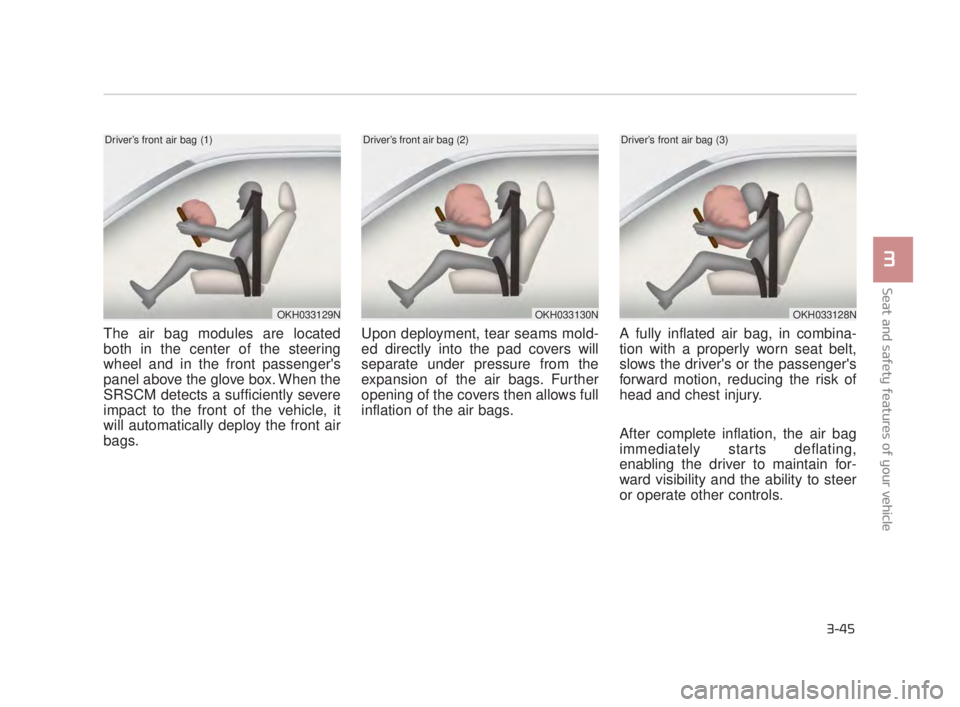
Seat and safety features of your vehicle
3
3-45
The air bag modules are located
both in the center of the steering
wheel and in the front passenger's
panel above the glove box. When the
SRSCM detects a sufficiently severe
impact to the front of the vehicle, it
will automatically deploy the front air
bags.Upon deployment, tear seams mold-
ed directly into the pad covers will
separate under pressure from the
expansion of the air bags. Further
opening of the covers then allows full
inflation of the air bags.
A fully inflated air bag, in combina-
tion with a properly worn seat belt,
slows the driver's or the passenger's
forward motion, reducing the risk of
head and chest injury.
After complete inflation, the air bag
immediately starts deflating,
enabling the driver to maintain for-
ward visibility and the ability to steer
or operate other controls.
OKH033130N
Driver’s front air bag (2)
OKH033128N
Driver’s front air bag (3)
OKH033129N
Driver’s front air bag (1)
KH USA 3:2018 4/18/2017 9:35 AM Page 45
Page 64 of 544
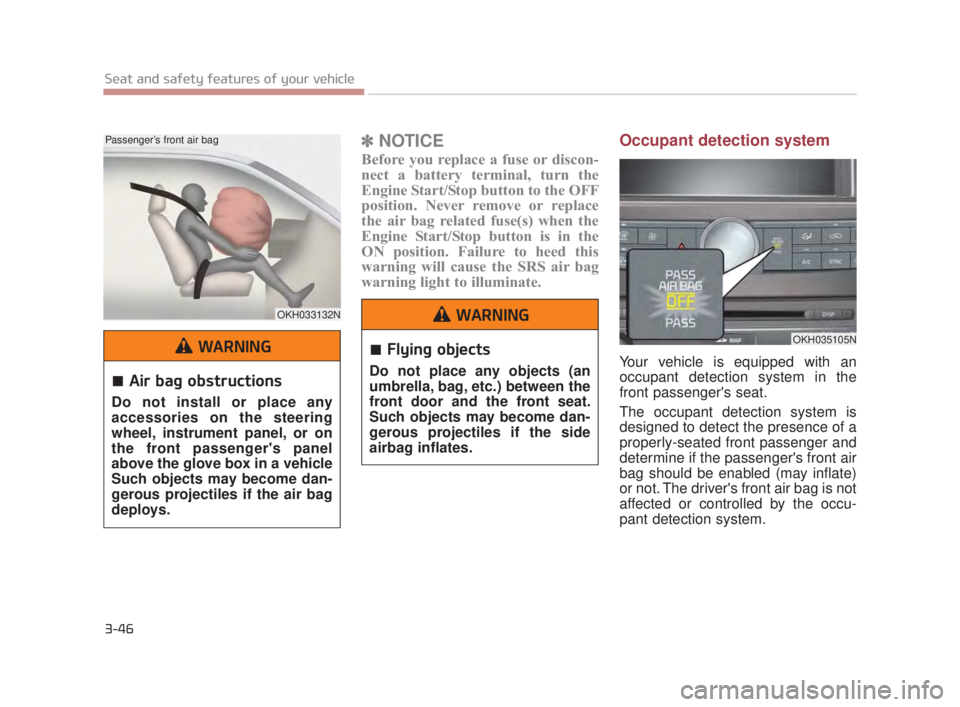
3-46
Seat and safety features of your vehicle
✽NOTICE
Before you replace a fuse or discon-
nect a battery terminal, turn the
Engine Start/Stop button to the OFF
position. Never remove or replace
the air bag related fuse(s) when the
Engine Start/Stop button is in the
ON position. Failure to heed this
warning will cause the SRS air bag
warning light to illuminate.
Occupant detection system
Your vehicle is equipped with an
occupant detection system in the
front passenger's seat.
The occupant detection system is
designed to detect the presence of a
properly-seated front passenger and
determine if the passenger's front air
bag should be enabled (may inflate)
or not. The driver's front air bag is not
affected or controlled by the occu-
pant detection system.
OKH033132N
Passenger’s front air bag
OKH035105N
Air bag obstructions
Do not install or place any
accessories on the steering
wheel, instrument panel, or on
the front passenger's panel
above the glove box in a vehicle
Such objects may become dan-
gerous projectiles if the air bag
deploys.
WARNINGFlying objects
Do not place any objects (an
umbrella, bag, etc.) between the
front door and the front seat.
Such objects may become dan-
gerous projectiles if the side
airbag inflates.
WARNING
KH USA 3:2018 4/18/2017 9:36 AM Page 46
Page 70 of 544

3-52
Seat and safety features of your vehicle
Driver's and passenger's front
air bag
Your vehicle is equipped with an
Advanced Supplemental Restraint
(Air Bag) System and lap/shoulder
belts at both the driver and passen-
ger seating position. The indications of the system's pres-
ence are the letters "AIR BAG"
embossed on the air bag pad cover
in the steering wheel and the pas-
senger's side front panel pad above
the glove box.
The SRS consists of air bags
installed under the pad covers in the
center of the steering wheel and the
passenger's side front panel above
the glove box.
The purpose of the SRS is to provide
the vehicle's driver and/or the front
passenger with additional protection
than that offered by the seat belt sys-
tem alone in case of a frontal impact
of sufficient severity. The SRS uses
sensors to gather information about
the driver's seat position, the driver's
and front passenger's seat belt
usage and impact severity.
The advanced SRS offers the ability
to control the air bag inflation with
two levels. A first stage level is pro-
vided for moderate-severity impacts.
A second stage level is provided for
more severe impacts.
The passenger’s front air bag is
designed to help reduce the injury of
children sitting close to the instru-
ment panel in low speed collisions.
However, children are safer if they
are restraint in the rear seat.
According to the impact severity,
seating position and seat belt usage,
the SRSCM (SRS Control Module)
controls the air bag inflation. Failure
to properly wear seat belts can
increase the risk or severity of injury
in an accident.
OKH033053N
Driver’s front air bag
OKH033055N
Passenger’s front air bag
KH USA 3:2018 4/18/2017 9:36 AM Page 52
Page 72 of 544
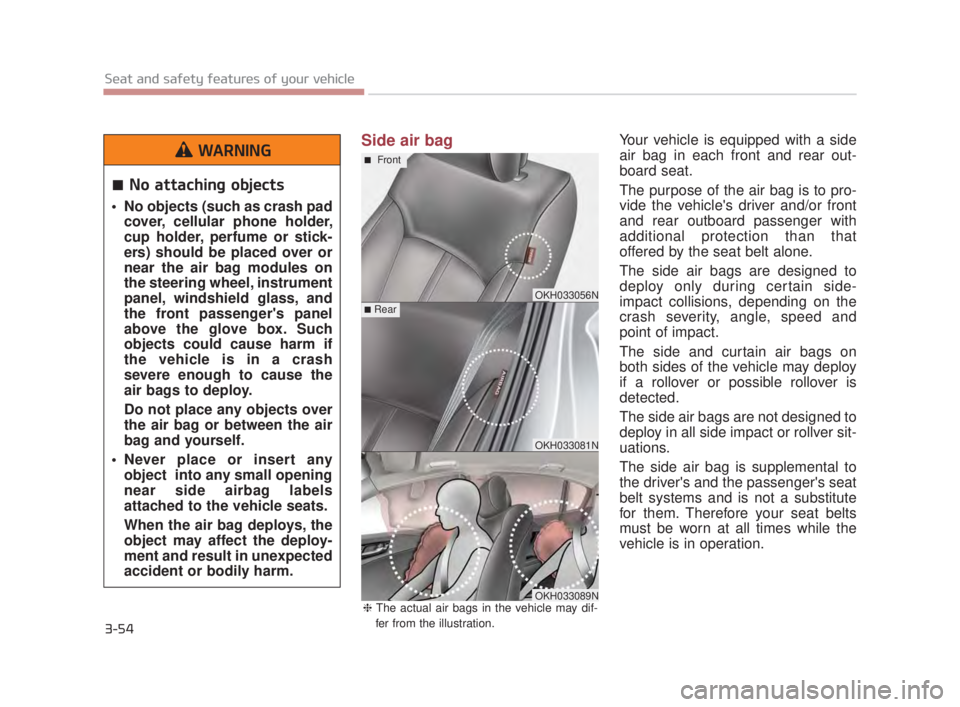
3-54
Seat and safety features of your vehicle
Side air bagYour vehicle is equipped with a side
air bag in each front and rear out-
board seat.
The purpose of the air bag is to pro-
vide the vehicle's driver and/or front
and rear outboard passenger with
additional protection than that
offered by the seat belt alone.
The side air bags are designed to
deploy only during certain side-
impact collisions, depending on the
crash severity, angle, speed and
point of impact.
The side and curtain air bags on
both sides of the vehicle may deploy
if a rollover or possible rollover is
detected.
The side air bags are not designed to
deploy in all side impact or rollver sit-
uations.
The side air bag is supplemental to
the driver's and the passenger's seat
belt systems and is not a substitute
for them. Therefore your seat belts
must be worn at all times while the
vehicle is in operation.
■Front
■RearOKH033056N
OKH033081N
OKH033089N❈The actual air bags in the vehicle may dif-
fer from the illustration.
No attaching objects
No objects (such as crash pad cover, cellular phone holder,
cup holder, perfume or stick-
ers) should be placed over or
near the air bag modules on
the steering wheel, instrument
panel, windshield glass, and
the front passenger's panel
above the glove box. Such
objects could cause harm if
the vehicle is in a crash
severe enough to cause the
air bags to deploy.
Do not place any objects over
the air bag or between the air
bag and yourself.
Never place or insert any object into any small opening
near side airbag labels
attached to the vehicle seats.
When the air bag deploys, the
object may affect the deploy-
ment and result in unexpected
accident or bodily harm.
WARNING
KH USA 3:2018 4/18/2017 9:36 AM Page 54
Page 91 of 544
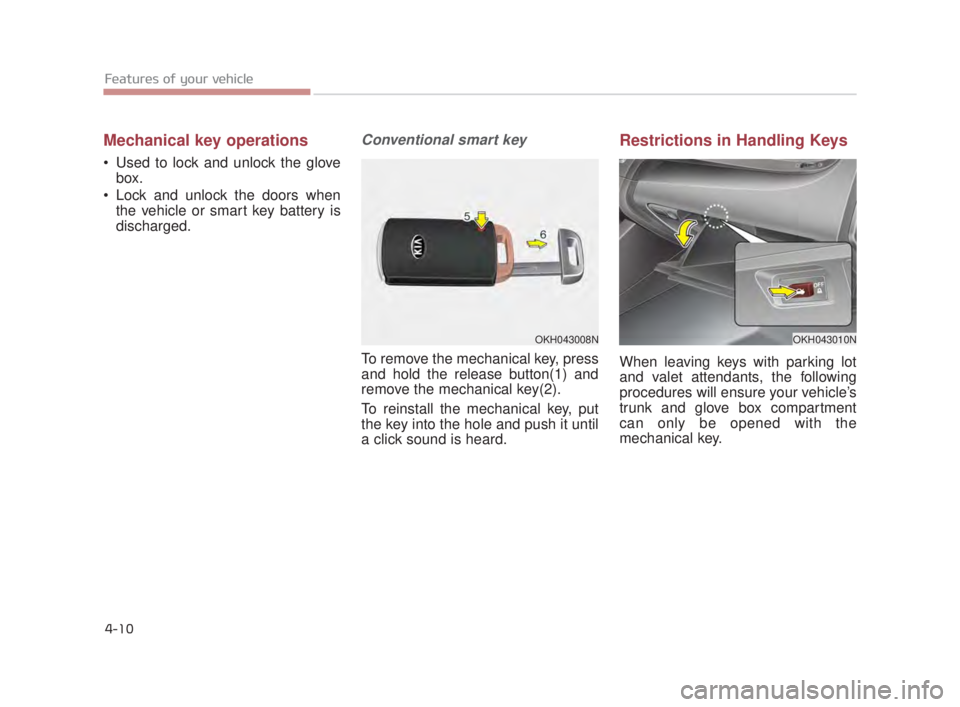
Features of your vehicle
4-10
Mechanical key operations
Used to lock and unlock the glovebox.
Lock and unlock the doors when the vehicle or smart key battery is
discharged.
Conventional smart key
To remove the mechanical key, press
and hold the release button(1) and
remove the mechanical key(2).
To reinstall the mechanical key, put
the key into the hole and push it until
a click sound is heard.
Restrictions in Handling Keys
When leaving keys with parking lot
and valet attendants, the following
procedures will ensure your vehicle’s
trunk and glove box compartment
can only be opened with the
mechanical key.
OKH043008NOKH043010N
KH USA 4:2018 4/18/2017 5:55 PM Page 10
Page 92 of 544
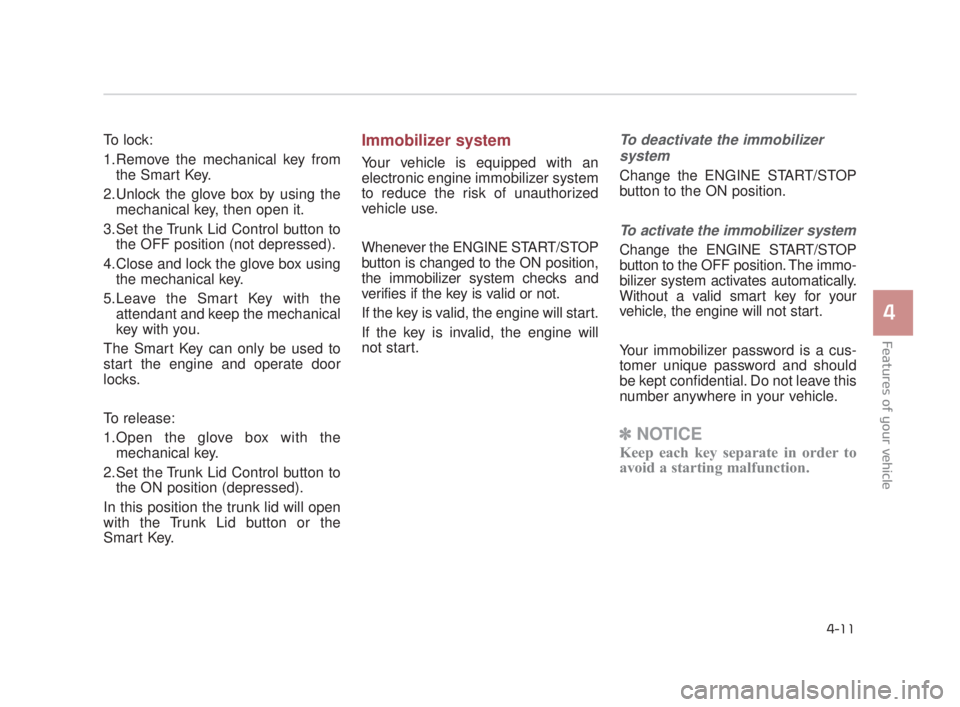
Features of your vehicle
4
4-11
To lock:
1.Remove the mechanical key fromthe Smart Key.
2.Unlock the glove box by using the mechanical key, then open it.
3.Set the Trunk Lid Control button to the OFF position (not depressed).
4.Close and lock the glove box using the mechanical key.
5.Leave the Smart Key with the attendant and keep the mechanical
key with you.
The Smart Key can only be used to
start the engine and operate door
locks.
To release:
1.Open the glove box with the mechanical key.
2.Set the Trunk Lid Control button to the ON position (depressed).
In this position the trunk lid will open
with the Trunk Lid button or the
Smart Key. Immobilizer system
Your vehicle is equipped with an
electronic engine immobilizer system
to reduce the risk of unauthorized
vehicle use.
Whenever the ENGINE START/STOP
button is changed to the ON position,
the immobilizer system checks and
verifies if the key is valid or not.
If the key is valid, the engine will start.
If the key is invalid, the engine will
not start.
To deactivate the immobilizer system
Change the ENGINE START/STOP
button to the ON position.
To activate the immobilizer system
Change the ENGINE START/STOP
button to the OFF position. The immo-
bilizer system activates automatically.
Without a valid smart key for your
vehicle, the engine will not start.
Your immobilizer password is a cus-
tomer unique password and should
be kept confidential. Do not leave this
number anywhere in your vehicle.
✽ NOTICE
Keep each key separate in order to
avoid a starting malfunction.
KH USA 4:2018 4/18/2017 5:55 PM Page 11
Page 107 of 544
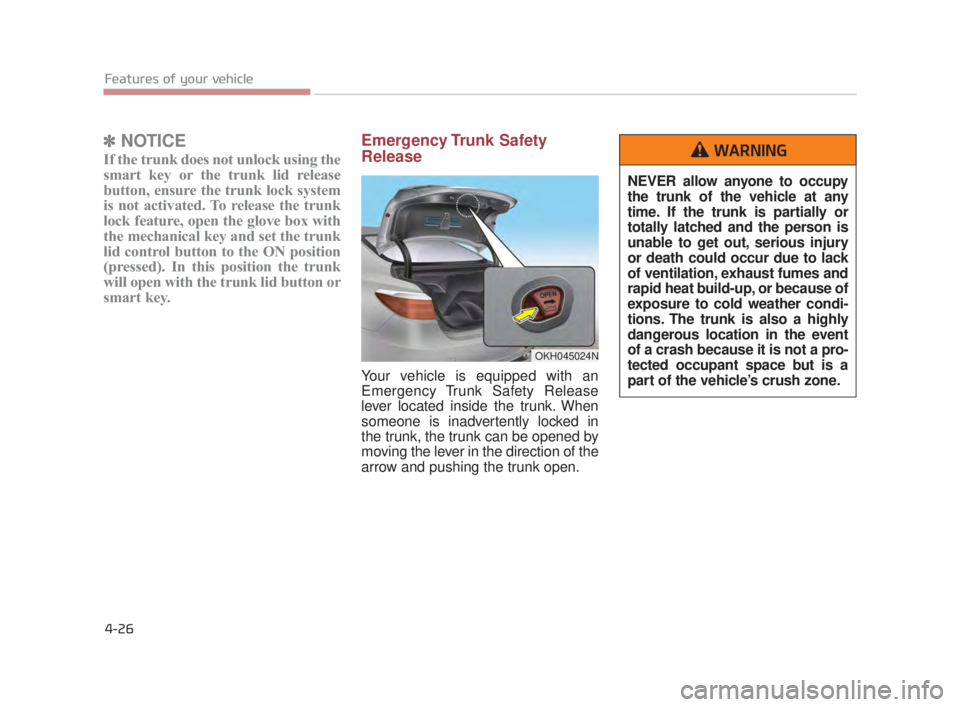
Features of your vehicle
4-26
✽NOTICE
If the trunk does not unlock using the
smart key or the trunk lid release
button, ensure the trunk lock system
is not activated. To release the trunk
lock feature, open the glove box with
the mechanical key and set the trunk
lid control button to the ON position
(pressed). In this position the trunk
will open with the trunk lid button or
smart key.
Emergency Trunk Safety
Release
Your vehicle is equipped with an
Emergency Trunk Safety Release
lever located inside the trunk. When
someone is inadvertently locked in
the trunk, the trunk can be opened by
moving the lever in the direction of the
arrow and pushing the trunk open.
OKH045024N
NEVER allow anyone to occupy
the trunk of the vehicle at any
time. If the trunk is partially or
totally latched and the person is
unable to get out, serious injury
or death could occur due to lack
of ventilation, exhaust fumes and
rapid heat build-up, or because of
exposure to cold weather condi-
tions. The trunk is also a highly
dangerous location in the event
of a crash because it is not a pro-
tected occupant space but is a
part of the vehicle’s crush zone.
WARNING
KH USA 4:2018 4/18/2017 5:56 PM Page 26